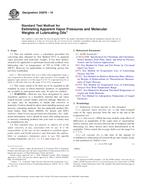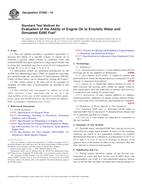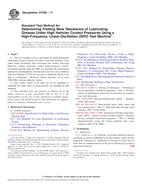Potřebujeme váš souhlas k využití jednotlivých dat, aby se vám mimo jiné mohly ukazovat informace týkající se vašich zájmů. Souhlas udělíte kliknutím na tlačítko „OK“.
ASTM D2878-10
Standard Test Method for Estimating Apparent Vapor Pressures and Molecular Weights of Lubricating Oils
Automaticky přeložený název:
Standardní zkušební metoda pro odhad Zjevné tlaky páry a molekulové hmotnosti, mazacích olejů
NORMA vydána dne 1.10.2010
Informace o normě:
Označení normy: ASTM D2878-10
Poznámka: NEPLATNÁ
Datum vydání normy: 1.10.2010
Kód zboží: NS-21800
Počet stran: 6
Přibližná hmotnost: 18 g (0.04 liber)
Země: Americká technická norma
Kategorie: Technické normy ASTM
Kategorie - podobné normy:
Anotace textu normy ASTM D2878-10 :
Keywords:
lubricating oils, molecular weight, vapor pressure, Evaporation loss, Lubricating oils, Molecular weight, Synthetic fluids, Vapor pressure (VPx)--petroleum products, ICS Number Code 75.100 (Lubricants, industrial oils and related products)
Doplňující informace
| Significance and Use | ||||||||||||||
|
The vapor pressure of a substance as determined by measurement of evaporation reflects a property of the bulk sample. Little weight is given by the procedure to the presence of low concentrations of volatile impurities. Vapor pressure, per se, is a thermodynamic property that is dependent only upon composition and temperature for stable systems. In the present method, composition changes occur during the course of the test so that the contribution of minor amounts of volatile impurities is minimized. |
||||||||||||||
| 1. Scope | ||||||||||||||
|
1.1 This test method covers a calculation procedure for converting data obtained by Test Method D972 to apparent vapor pressures and molecular weights. It has been demonstrated to be applicable to petroleum-based and synthetic ester lubricating oils, at temperatures of 395 to 535K (250 to 500°F). However, its applicability to lubricating greases has not been established. Note 1—Most lubricants boil over a fairly wide temperature range, a fact recognized in discussion of their vapor pressures. For example, the apparent vapor pressure over the range 0 to 0.1 % evaporated may be as much as 100 times that over the range 4.9 to 5.0 % evaporated. 1.2 The values stated in SI units are to be regarded as the standard. In cases in which materials, products, or equipment are available in inch-pound units only, SI units are omitted. 1.3 WARNINGMercury has been designated by many regulatory agencies as a hazardous material that can cause central nervous system, kidney and liver damage. Mercury, or its vapor, may be hazardous to health and corrosive to materials. Caution should be taken when handling mercury and mercury containing products. See the applicable product Material Safety Data Sheet (MSDS) for details and EPA’s websitehttp://www.epa.gov/mercury/faq.htmfor additional information. Users should be aware that selling mercury or mercury containing products into your state or country may be prohibited by law. 1.4 This standard does not purport to address all of the safety concerns, if any, associated with its use. It is the responsibility of the user of this standard to establish appropriate safety and health practices and determine the applicability or regulatory limitations prior to use. For specific warning statements, see 6.2, 7.1, 8.2, and Annex A2. |
||||||||||||||
| 2. Referenced Documents | ||||||||||||||
|
Podobné normy:
Historická
1.5.2014
Historická
1.1.2010
Historická
15.2.2010
Historická
1.5.2014
Historická
1.12.2013
Historická
1.12.2011



 ASTM D7549-14
ASTM D7549-14 ASTM D7563-10
ASTM D7563-10 ASTM D7578-10e1
ASTM D7578-10e1 ASTM D7590-09(2014)..
ASTM D7590-09(2014).. ASTM D7593-13
ASTM D7593-13 ASTM D7594-11
ASTM D7594-11
 Cookies
Cookies
